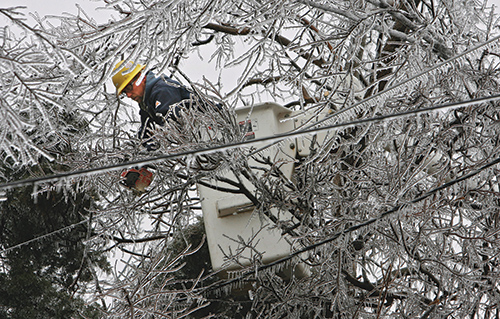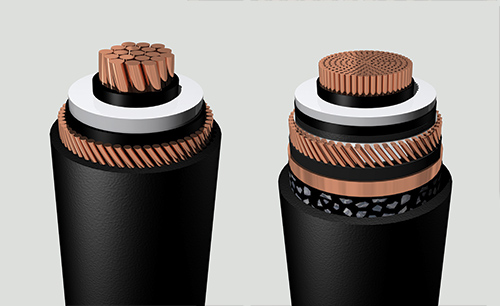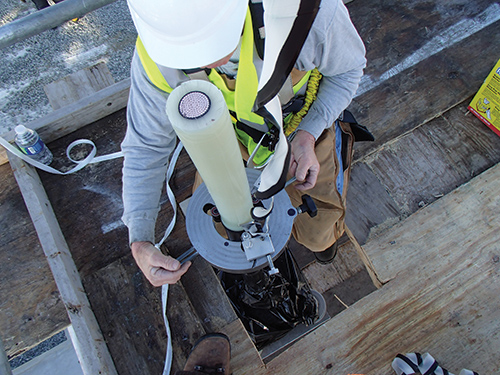‘Be Prepared’ certainly has grown beyond the purview of the Boy Scout motto. Being prepared is at the heart of the ability to anticipate unexpected events, know what you intend to do to survive or mitigate risk from that event, and how quickly you can bounce back. In a word, resiliency. The same view that we employ on an individual level pertains to the infrastructure that supports our daily lives. This has become painfully clear during the last decade as we’ve experienced unprecedented weather events that have displaced people and disrupted economies. Whether you believe that climate change is a result of human-kind’s poor stewardship of the earth or that it is simply a cyclical event that happens naturally every few thousand years, we are feeling the effects. When it comes to power systems we have to think beyond the cleanup. We need to come together as an industry to plan for system resiliency, not just reliability under normal operating circumstances. Intelligent Undergrounding – the concept of burying transmission and distribution lines where it makes sense – supports both reliability and resiliency.
In its November 2013 report, Resilience in Regulated Utilities, The National Association of Regulatory Utility Commissioners (NARUC) defined resilience as ‘Robustness and recovery characteristics of utility infrastructure and operations, which avoid or minimize interruptions of service during an extraordinary and hazardous event.’ The report went on to state that “If an investment avoids or minimizes service interruptions in the absence of an extraordinary event, it’s just an everyday reliability investment… resilient infrastructure does more than one thing well, because a resilience investment needs to pay for itself and create value for ratepayers, even when it’s not being used.” In other words, whether we’re talking about a local storm that affects thousands or a catastrophic event that affects millions, we need to proactively consider investments in new or rehabilitated infrastructure that effectively builds in resiliency from the start, not just as part of post-event restoration.
The Case for Intelligent Undergrounding
In an op-ed article for the Wall Street Journal, In Sandy’s Wake, Time to Upgrade the Power Grid, former New York Governor, George Pataki, offered that “To make our electrical grid more reliable, serious consideration has to be given to burying electrical distribution networks underground. This costly but critical investment would eliminate the need for utility poles and overhead wires, drastically reducing the need for repairs caused by wind and tree damage.” He went on to further argue that “Another priority should be to harden and modernize the transmission systems that carry high-voltage electricity from large power plants down to the local distribution level.”
The entire value chain, from compound suppliers, accessory component producers to cable makers, installers and utilities, has a vested interest in improving electrical system reliability and resiliency. Undergrounding distribution and transmission networks can and should be considered as part of the solution. While it’s a fact that high-voltage underground transmission installations typically have higher up-front price tags than overhead lines (OHL), new trenching methods along with technologies that create more reliable, long-life cables, are helping to move costs to a more equitable position with OHL. This is where the concept of Intelligent Undergrounding comes into play.
Beyond advantages in securing rights of way or improving aesthetics and property values, the case for undergrounding jumps to the forefront when considered in the light of storm outages and subsequent system restoration. Urban areas can be particularly vulnerable when seen in the light of lessons from Superstorm Sandy, Hurricane Irene and last winter’s polar vortices. Similarly, although affecting fewer ratepayers, weather-related outages in rural areas can bring homes and businesses to a standstill. It’s clear that systems supported primarily by overhead lines and utility poles are much more susceptible to failure due to high winds, heavy snow and ice.

Across North America, we see more instances in both rural and urban environments where utilities, regulators and planners are working together to improve reliability in their regions. A noteworthy example was recently cited in the July 2014 issue of Transmission & Distribution World in an article that showcased the cooperation between San Diego Gas & Electric and the City of San Diego in undergrounding 75 percent of San Diego’s power lines since 2003 – with plans “to underground approximately 1,000 miles of remaining overhead.” The article went on to note that “Undergrounding reduces the possibility of power lines being affected by car accidents, high winds during storms and other adverse factors. This strengthens the infrastructure of the region’s electric power system in order to further promote reliability and make the system more resilient under a variety of operating conditions.”
Who Foots the Bill?
Cost recovery remains a hot topic when contemplating both necessary and preemptive investment in power systems. Further complicating matters is that there is currently no clear precedent on who pays – the ratepayer, the utility/service provider, the government or a combination of all of them.
ITC Holdings Group recently released a white paper The Economic Case for Grid Investment that includes research findings from a survey of 800 U.S. adults and in-depth interviews with business leaders at Fortune 500 and mid-size companies and economic development organizations. Ninety-three percent of those surveyed felt that “investing in the electricity transmission grid will ensure reliable access to power, especially during severe storms, for consumers and businesses.” However, as the white paper acknowledges, “Despite agreement around the benefits of investing in the grid, Americans are divided over who is primarily responsible for actually investing in it. More than half (56%) say either federal (Congress) or local/state government is responsible for investing in the grid, while a quarter say electric utility companies are. Small percentages think that President Obama, consumers or private investors are responsible.”
A recent Grid Resiliency Survey conducted by GE’s Digital Energy business found that of the 2,000 adults surveyed, 41 percent of Americans living east of the Mississippi River are more willing to pay an additional $10 per month to ensure the grid is more reliable. The survey noted that those living east of the Mississippi experienced three times more power outages than those living west of the Mississippi. As quoted in a news release from GE summarizing the survey, John McDonald, director of technical strategy and policy development for GE’s Digital Energy business offered, “The survey results are an indicator that consumers want to invest in technology to prevent power outages and reduce the time it takes their local utility to restore power.” This sentiment is echoed, especially in the Midwest, Northeast and Atlantic coast regions most recently affected by severe weather events. Other sources indicate that Americans are willing to pay between $4 and $40 more per month per household to aid in both cost recovery efforts for grid restoration and for investment in new or improved infrastructure that is better equipped to maintain reliable operation or more quickly recover under adverse conditions.
Federal funding is more problematic. As further supported in George Pataki’s Wall Street Journal article, “…the way the Federal Emergency Management Agency works with electrical utilities after disasters needs reform. Under the current system, utilities receive federal emergency funding to replace damaged electrical components only if they replace them ‘in kind’ with the same technology. This means that all sorts of antiquated components are simply being replaced. This makes no sense. The federal government should promote modern technologies and best practices.”
Experts from Ernst & Young Power & Utilities Advisory Practice throw the baton back to utilities. In an article from May 2014’s Powergrid International, these experts state that “Given today’s challenging regulatory environment, utilities should develop a storm response plan to optimize the likelihood of cost recovery. The time to consider planning for storm recovery begins well before any storm.”
While a comprehensive storm response plan will help restore power more quickly, the goal should be to prevent the power from going out. Understanding key elements of the grid and knowing which elements are most vulnerable – then proactively upgrading them – will reduce the number of outages. The principles of Intelligent Undergrounding offer proven ways to reduce storm related outages and improve the resiliency of the grid.
With all this being said, when it comes to investing in resilient systems, consideration needs to be given to total lifetime system cost. Quality-made underground cables can deliver 40+ years of service with less likelihood of failure or ongoing maintenance costs normally associated with OHL. So, for whatever combination of parties that ultimately foots the bill, the potential return on investment for undergrounding appears quite attractive.
Quality Materials Matter
Cable compound suppliers are a critical part of the value chain in the power industry and can have a huge impact on power system reliability. Cable manufacturers and utilities have many choices when it comes to specifying materials to manufacture cables. Years of experience and data from independent testing institutes indicate that cross-linked polyethylene (XLPE) for high-voltage transmission and tree-retardant XLPE (TR-XLPE) for medium-voltage distribution underground cables continue to provide the best performance for robust manufacturing, ease of installation and high electrical breakdown strength that ensures failure-free operation and lower electrical losses over the lifetime of the cable. Compound suppliers also recommend a systems approach when considering cable construction. Highly-engineered insulation, jacketing and semiconductive compounds are designed to work together for the best result. Quality materials made to meet or exceed stringent industry standards are key to long-life, reliable cables that extend that reliability and resiliency to the underground systems in which they are placed.

Figure on left is typical construction of a medium-voltage underground cable utilizing TR-XLPE solid insulation. Figure on right is typical construction of a high-voltage underground cable with PE-based jacketing and semiconductive layers and super-clean XLPE solid insulation.

High-voltage underground cable installation (photo courtesy of Southwire)
Investing for the Future
Perhaps songwriters Burton Lane and Alan Jay Lerner said it best in the play and song of the same name: “On a clear day you can see forever.” It’s true. In a clear skies scenario, maintaining reliability in power systems during normal everyday operating conditions is hitting the mark. However, planning ahead to invest in system resiliency that is required to prevent or quickly recover from outages caused by stormy weather is expensive but essential. Intelligent Undergrounding needs to be part of that solution. The time has come for the industry value chain to share best practices, factoring in total system lifetime costs based on increasing reliability and resiliency. This does not mean that there isn’t a place for overhead lines – it just means that underground and overhead can be planned and installed together in a way that makes sense to best serve businesses and communities that rely on power at every flip of a switch or push of a button, even under adverse conditions.
No matter what side of the fence you’re on concerning climate change, Paul Mauldin in a recent post in Transmission & Distribution World’s The Grid Optimization Blog, aptly stated that “The silver lining in climate change hysteria is this: we can expect accelerated adoption of new methodologies and technologies which will improve service even between storms.”
That’s the target we’re all aiming for. Proactive improvement and hardening of power systems is the right thing to do. Power supports economies. Power ensures the connectivity that is essential to human progress. Value chain partners working together to invest in a common desirable outcome will reap the reward of trust and satisfaction from power consuming customers – along with resiliency for the grid and for our businesses.
About the Authors
 Damien Polansky is Global Strategic Marketing Director Dow Electrical & Telecommunications (Dow E&T), a business unit of The Dow Chemical Company. In this role Damien is responsible for creating and driving the long-term strategic vision of Dow’s participation in the electrical transmission and distribution industry. Since joining Dow in 1997, Damien has worked for Dow in several business units across many functions including manufacturing, technical service, Six Sigma Blackbelt, sales, and marketing. Damien holds a Bachelor of Science degree in Chemical Engineering from the University of Texas at Austin and an MBA from the University of Notre Dame.
Damien Polansky is Global Strategic Marketing Director Dow Electrical & Telecommunications (Dow E&T), a business unit of The Dow Chemical Company. In this role Damien is responsible for creating and driving the long-term strategic vision of Dow’s participation in the electrical transmission and distribution industry. Since joining Dow in 1997, Damien has worked for Dow in several business units across many functions including manufacturing, technical service, Six Sigma Blackbelt, sales, and marketing. Damien holds a Bachelor of Science degree in Chemical Engineering from the University of Texas at Austin and an MBA from the University of Notre Dame.
 In this role as North American Manager of End Use Marketing, Brent Richardson represents Dow’s Electrical & Telecommunications business to the utility industry in North America. Prior to joining Dow in May of 2007, Brent worked for nearly 25 years for Duke Energy in Charlotte, NC. His experience includes many components of the utility business including Field Engineering, Distribution Standards, Project and Product Management and Marketing. He received a BS in Electrical Engineering from Virginia Tech and is a registered Professional Engineer in NC and SC. He is also a voting member of IEEE Power and Energy Society and the ICC and has written and presented numerous papers to the IEEE, the ICC and other industry groups. Brent serves as Vice Chair of the ICC A14D – Cable Standards subcommittee.
In this role as North American Manager of End Use Marketing, Brent Richardson represents Dow’s Electrical & Telecommunications business to the utility industry in North America. Prior to joining Dow in May of 2007, Brent worked for nearly 25 years for Duke Energy in Charlotte, NC. His experience includes many components of the utility business including Field Engineering, Distribution Standards, Project and Product Management and Marketing. He received a BS in Electrical Engineering from Virginia Tech and is a registered Professional Engineer in NC and SC. He is also a voting member of IEEE Power and Energy Society and the ICC and has written and presented numerous papers to the IEEE, the ICC and other industry groups. Brent serves as Vice Chair of the ICC A14D – Cable Standards subcommittee.







